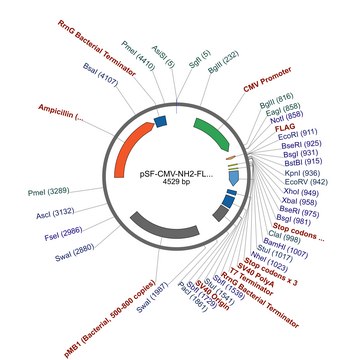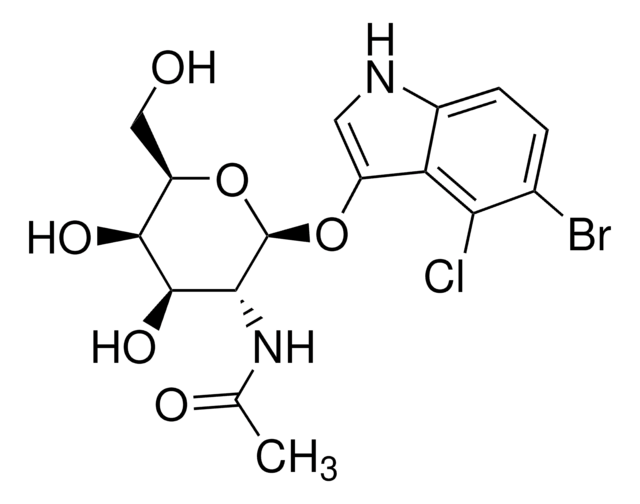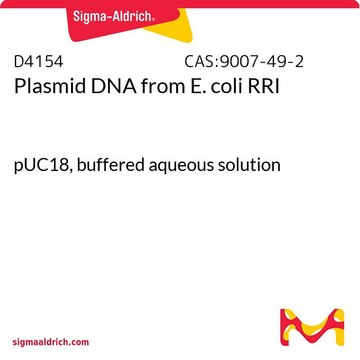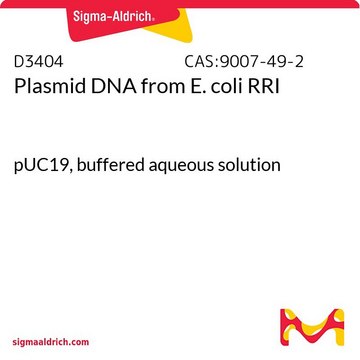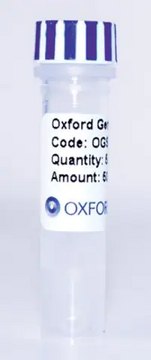E6783
pFLAG-CMV-3 Expression Vector
shuttle vector for transient or stable expression of N-terminal FLAG
Sign Into View Organizational & Contract Pricing
All Photos(2)
About This Item
UNSPSC Code:
12352200
Recommended Products
tag
FLAG® tagged
grade
for molecular biology
form
buffered aqueous solution
Peptide tag location
N-terminal
shipped in
dry ice
storage temp.
−20°C
General description
The pFLAG-CMV™-3 Expression Vector is a 6.3 kb vector used for transient or stable expression in
mammalian cells. The vector is a derivative of pCMV5 used for transient or stable expression and secretion of a properly inserted open reading frame as an N-terminal FLAG fusion protein.
The pFLAG-CMV-3 Expression Vector is a shuttle vector containing both bacterial and SV40 origins of replication for propagation in both E. coli and mammalian cells. Efficiency of replication and genomic integration is optimal when using host cells that express the SV40 large T antigen.
The pFLAG-CMV-3-BAP Control Plasmid is a 7.7 kb derivative of pCMV51 used for transient expression and secretion of N-terminal FLAG bacterial alkaline phosphatase fusion protein in mammalian cells.
The FLAG® epitope is a small, hydrophilic 8 amino acid tag (DYKDDDDK) that provides for sensitive detection and high quality purification using ANTI-FLAG products available from Sigma-Aldrich.
Vector Maps and Sequences
mammalian cells. The vector is a derivative of pCMV5 used for transient or stable expression and secretion of a properly inserted open reading frame as an N-terminal FLAG fusion protein.
The pFLAG-CMV-3 Expression Vector is a shuttle vector containing both bacterial and SV40 origins of replication for propagation in both E. coli and mammalian cells. Efficiency of replication and genomic integration is optimal when using host cells that express the SV40 large T antigen.
The pFLAG-CMV-3-BAP Control Plasmid is a 7.7 kb derivative of pCMV51 used for transient expression and secretion of N-terminal FLAG bacterial alkaline phosphatase fusion protein in mammalian cells.
The FLAG® epitope is a small, hydrophilic 8 amino acid tag (DYKDDDDK) that provides for sensitive detection and high quality purification using ANTI-FLAG products available from Sigma-Aldrich.
Vector Maps and Sequences
Application
pFLAG-CMV™-3 Expression Vector is suitable for transient or stable expression and secretion of N-terminal FLAG-tagged fusion proteins in mammalian cells.
Components
- pFLAG-CMV™-3 Expression Vector 20 μg (E8770) is supplied as 0.5 mg/ml in 10 mM Tris-HCl (pH 8.0) with 1 mM EDTA.
- pFLAG-CMV™-3-BAP Control Plasmid 20 μg (C3972) is supplied as 0.5 mg/ml in 10 mM Tris-HCl (pH 8.0) with 1 mM EDTA.
Principle
The promoter-regulatory region of the human cytomegalovirus drives transcription of FLAG-fusion constructs. The preprotrypsin leader sequence precedes the FLAG® sequence and directs secretion of the fusion protein into the culture medium. The aminoglycoside phosphotransferase II gene (neo-r) confers resistance to aminoglycosides such as G 418, allowing for selection of stable transfectants.
Legal Information
FLAG is a registered trademark of Merck KGaA, Darmstadt, Germany
pFLAG-CMV is a trademark of Sigma-Aldrich Co. LLC
related product
Storage Class Code
10 - Combustible liquids
Regulatory Information
新产品
Choose from one of the most recent versions:
Certificates of Analysis (COA)
Lot/Batch Number
It looks like we've run into a problem, but you can still download Certificates of Analysis from our Documents section.
If you need assistance, please contact Customer Support.
Already Own This Product?
Find documentation for the products that you have recently purchased in the Document Library.
Koichi Ushizawa et al.
PloS one, 4(6), e5814-e5814 (2009-06-09)
Ly-6 superfamily members have a conserved Ly-6 domain that is defined by a distinct disulfide bonding pattern between eight or ten cysteine residues. These members are divided into membrane-type and secretory-type proteins. In the present study, we report the identification
Aidan L Huene et al.
iScience, 24(7), 102811-102811 (2021-07-24)
Many organisms use genetic self-recognition systems to distinguish themselves from conspecifics. In the cnidarian, Hydractinia symbiolongicarpus, self-recognition is partially controlled by allorecognition 2 (Alr2). Alr2 encodes a highly polymorphic transmembrane protein that discriminates self from nonself by binding in trans
M Kokel et al.
Genes & development, 12(10), 1425-1437 (1998-05-29)
Receptor tyrosine phosphatases have been implicated in playing important roles in cell signaling events by their ability to regulate the level of protein tyrosine phosphorylation. Although the catalytic activity of their phosphatase domains has been well established, the biological roles
Expression of human MDGA1 increases cell motility and cell-cell adhesion and reduces adhesion to extracellular matrix proteins in MDCK cells.
Diaz-Lopez, A., et al.
Cancer Microenvironment, 4, 23-23 (2011)
Raogo Ouedraogo et al.
Diabetes, 55(6), 1840-1846 (2006-05-30)
Adiponectin is an abundant adipocyte-derived plasma protein with antiatherosclerotic effects. Vascular signal transduction by adiponectin is poorly understood and may involve 5'-AMP-activated protein kinase (AMPK), cAMP signaling, and other pathways. Hyperglycemia sharply increases the production of reactive oxygen species (ROS)
Our team of scientists has experience in all areas of research including Life Science, Material Science, Chemical Synthesis, Chromatography, Analytical and many others.
Contact Technical Service
